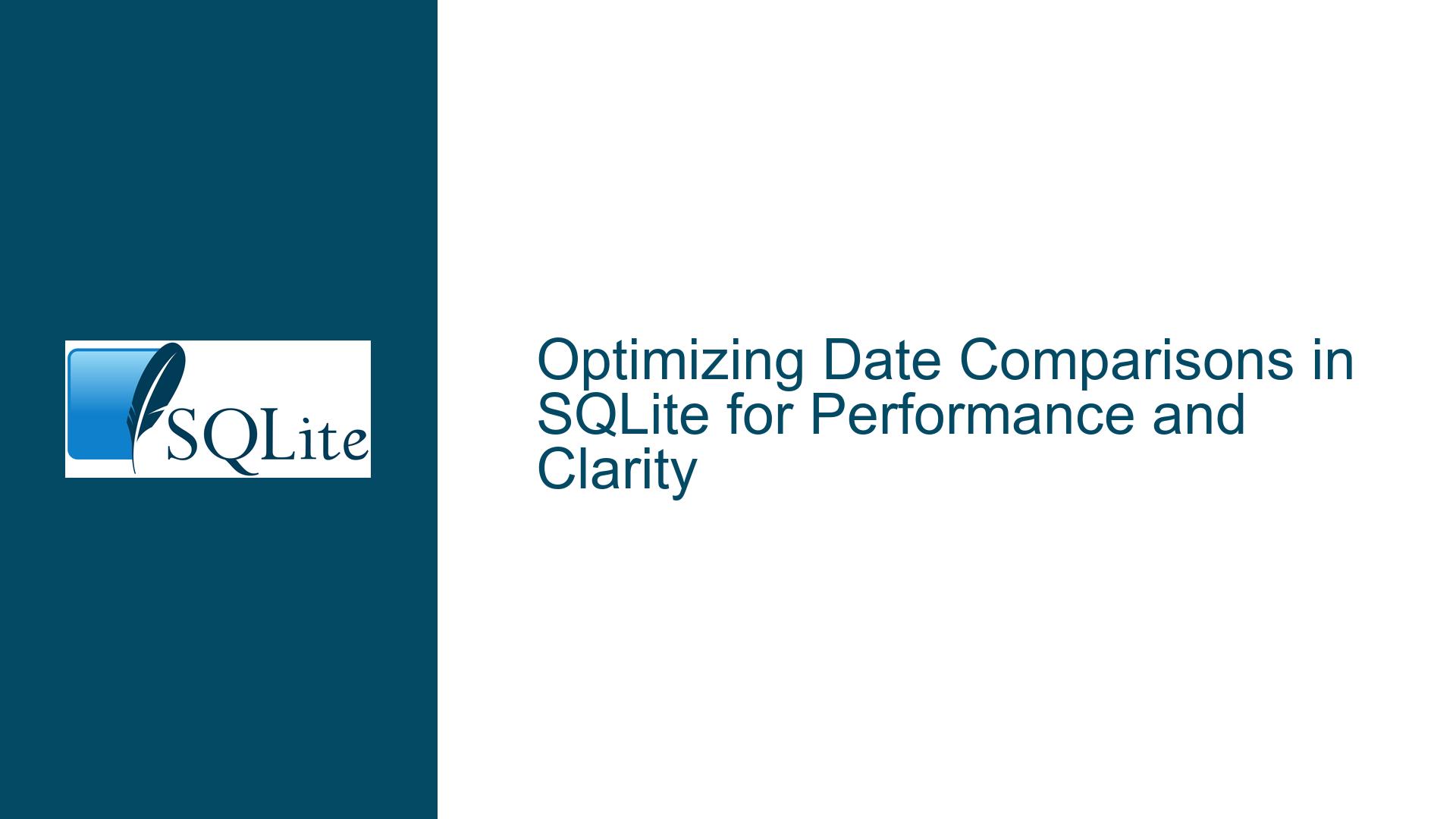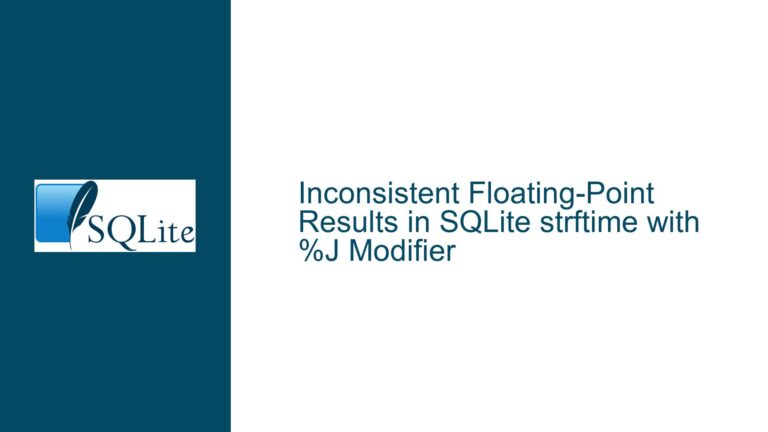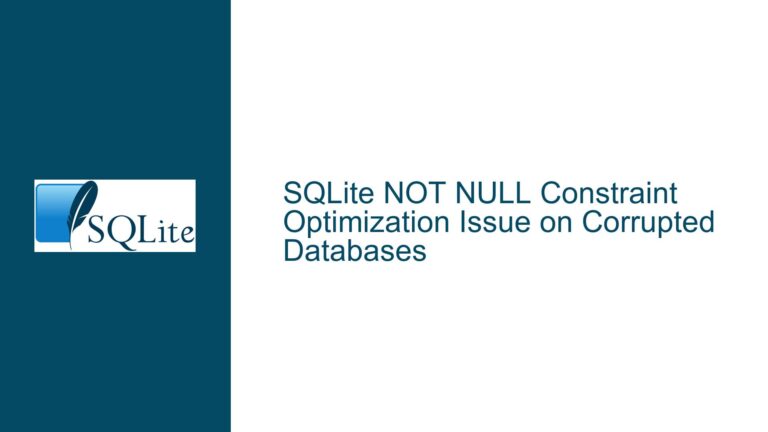Optimizing Date Comparisons in SQLite for Performance and Clarity
Understanding Date Storage and Comparison in SQLite
SQLite, being a lightweight and versatile database, offers flexibility in how dates are stored and compared. However, this flexibility can lead to confusion and inefficiencies if not handled properly. The core issue revolves around the comparison of dates stored in the YYYY-MM-DD format and whether using strftime('%s', date) for conversion to Unix timestamps is necessary or if direct string comparison suffices. This post delves into the nuances of date storage, the implications of different comparison methods, and provides actionable steps to optimize date comparisons in SQLite.
The Impact of Date Format on Comparison Efficiency
The format in which dates are stored in SQLite significantly impacts the efficiency and simplicity of date comparisons. When dates are stored as strings in the YYYY-MM-DD format, they can be compared directly using relational operators like <, >, and =. This is because the lexicographical order of strings in this format corresponds to the chronological order of dates. For instance, 2022-09-01 is lexicographically less than 2022-09-02, which aligns with their chronological order.
However, when dates are stored in other formats or when additional operations like conversion to Unix timestamps are performed, the comparison process becomes more complex and computationally expensive. The use of strftime('%s', date) converts the date string to a Unix timestamp, which is the number of seconds since the Unix epoch (1970-01-01 00:00:00 UTC). While this conversion allows for numerical comparison, it introduces unnecessary overhead, especially when the dates are already in a comparable string format.
In the provided query, the dates are stored in the YYYY-MM-DD format, which is ideal for direct string comparison. The use of strftime('%s', date) is redundant and can be eliminated to simplify the query and improve performance. Direct comparison of date strings not only reduces the computational load but also enhances the readability and maintainability of the SQL code.
Strategies for Optimizing Date Comparisons in SQLite
To optimize date comparisons in SQLite, it is essential to ensure that dates are stored in a format that allows for direct comparison. The YYYY-MM-DD format is highly recommended for this purpose. Once the dates are stored in this format, the following strategies can be employed to optimize date comparisons:
Direct String Comparison: As mentioned earlier, dates stored in the
YYYY-MM-DDformat can be compared directly using relational operators. This approach is both efficient and straightforward. For example,a.Finish_Date > a.Start_dateis a valid and efficient comparison when both dates are in theYYYY-MM-DDformat.Avoiding Unnecessary Conversions: The use of functions like
strftime('%s', date)should be avoided unless absolutely necessary. Converting dates to Unix timestamps adds computational overhead and complicates the query. In most cases, direct string comparison is sufficient and more efficient.Indexing Date Columns: To further enhance the performance of date comparisons, especially in large datasets, it is advisable to create indexes on the date columns. Indexes allow SQLite to quickly locate and compare dates without scanning the entire table. For example, creating an index on the
Finish_DateandStart_datecolumns can significantly speed up queries that involve date comparisons.Consistent Date Formats: Ensuring that all dates in the database are stored in a consistent format is crucial. Inconsistent date formats can lead to errors and inefficiencies in date comparisons. The
YYYY-MM-DDformat is widely recognized and supported, making it an ideal choice for date storage in SQLite.Using Date Functions Wisely: SQLite provides several date and time functions that can be useful in certain scenarios. However, these functions should be used judiciously to avoid unnecessary complexity. For example, the
date('now')function can be used to get the current date in theYYYY-MM-DDformat, which can then be compared directly with other dates in the same format.
By implementing these strategies, you can optimize date comparisons in SQLite, resulting in faster and more efficient queries. The key is to leverage the inherent properties of the YYYY-MM-DD format and avoid unnecessary conversions and computations.
Detailed Troubleshooting Steps and Solutions for Date Comparison Issues
When dealing with date comparisons in SQLite, it is important to follow a systematic approach to identify and resolve any issues. The following steps provide a comprehensive guide to troubleshooting and optimizing date comparisons:
Verify Date Formats: The first step is to ensure that all dates in the database are stored in the
YYYY-MM-DDformat. This can be done by running a query to check the format of the date columns. For example:SELECT Finish_Date, Start_date FROM Project_List LIMIT 10;If the dates are not in the
YYYY-MM-DDformat, you will need to convert them. This can be done using thestrftimefunction or by updating the data insertion logic to ensure consistent formatting.Simplify Date Comparisons: Once the dates are in the correct format, you can simplify the date comparisons by removing unnecessary conversions. For example, replace:
strftime('%s', a.Finish_Date) > strftime('%s', a.Start_date)with:
a.Finish_Date > a.Start_dateThis change reduces the computational load and makes the query easier to read and maintain.
Create Indexes on Date Columns: To improve the performance of date comparisons, create indexes on the date columns. For example:
CREATE INDEX idx_finish_date ON Project_List(Finish_Date); CREATE INDEX idx_start_date ON Project_List(Start_date);Indexes allow SQLite to quickly locate and compare dates, resulting in faster query execution.
Optimize Complex Queries: For complex queries that involve multiple date comparisons, consider breaking down the query into smaller, more manageable parts. Use Common Table Expressions (CTEs) to simplify the logic and improve readability. For example, the provided query can be optimized by removing unnecessary conversions and ensuring that all date comparisons are performed directly on the
YYYY-MM-DDformatted strings.Test and Validate: After making the necessary changes, thoroughly test the queries to ensure that they produce the correct results and perform efficiently. Use the
EXPLAIN QUERY PLANstatement to analyze the query execution plan and identify any potential bottlenecks. For example:EXPLAIN QUERY PLAN SELECT a.ProjID, a.CID, a.Project_Name AS PN, a.Manager AS CPM, a.PMO_Board_Report AS PMO_Rpt, a.Project_Type AS PT, c.TaskName AS TN, c.StartDate AS SD, c.FinishDate AS FD, c.Status, c.Milestone, c.KeyTask, ( CASE WHEN -- Deliverables not completed c.FinishDate <= f.today AND c.Status != 'Completed' AND c.KeyTask = '1' AND c.Milestone = '1' THEN 'Deliverable not completed' WHEN -- Deliverables soon to be completed c.FinishDate > f.today AND c.FinishDate <= f.eom AND c.Status != 'Completed' AND c.KeyTask = '1' AND c.Milestone = '1' THEN 'Deliverable soon to be completed' WHEN -- Tasks not completed c.FinishDate <= f.today AND c.Status != 'Completed' AND c.KeyTask = '1' AND c.Milestone != '1' THEN 'Task not completed' WHEN -- Tasks not Started c.StartDate <= f.today AND c.Status = 'Not Started' AND c.KeyTask = '1' AND c.Milestone != '1' THEN 'Task not started' WHEN -- Milestones not completed c.FinishDate <= f.today AND c.Status != 'Completed' AND c.Milestone = '1' AND c.KeyTask != '1' THEN 'Milestone not completed' WHEN -- Milestones soon to be completed c.FinishDate > f.today AND c.FinishDate <= f.eom AND c.Status != 'Completed' AND c.Milestone = '1' AND c.KeyTask != '1' THEN 'Milestone soon to be completed' END ) AS msg FROM Project_List AS a LEFT JOIN Project_Extras AS b ON b.ProjID == a.ProjID AND a.Active != 'No' AND a.PMO_Board_Report != 'No' AND a.Status == 'Acknowledged' AND b.FinCarryOver != 'y' AND b.MonthlyRpt = 'y' AND b.BudgetYear = 'YYYY' LEFT JOIN Project_Keytask_and_Milestones AS c ON c.ProjID = b.ProjID AND c.Taskname NOT LIKE '%cost tracking%' AND ( ( -- Deliverables ( c.KeyTask = '1' AND c.Milestone = '1' ) AND c.FinishDate <= f.eom AND c.Status != 'Completed' ) OR ( -- Keytasks Not Completed c.KeyTask = '1' AND c.Milestone != '1' AND c.FinishDate <= f.today AND c.Status != 'Completed' ) OR ( -- Keytasks Not Started c.KeyTask = '1' AND c.Milestone != '1' AND c.StartDate <= f.today AND c.Status = 'Not Started' ) OR ( -- MIlestones c.Milestone = '1' AND c.KeyTask != '1' AND c.FinishDate <= f.eom AND c.Status != 'Completed' ) ) LEFT JOIN Init AS f WHERE a.ProjID = f.projid AND a.InsertDate = f.pl_insert AND b.InsertDate = f.pe_insert AND c.InsertDate = f.ml_insert ORDER BY a.Manager, a.ProjID;This will provide insights into how SQLite is executing the query and help identify any areas for further optimization.
Monitor Performance: After deploying the optimized queries, monitor their performance in a production environment. Use SQLite’s built-in performance monitoring tools or external tools to track query execution times and resource usage. If any performance issues are detected, revisit the optimization steps and make further adjustments as needed.
By following these troubleshooting steps and implementing the recommended solutions, you can ensure that date comparisons in SQLite are both efficient and accurate. The key is to leverage the strengths of SQLite’s date handling capabilities while avoiding common pitfalls that can lead to performance degradation and complexity.






